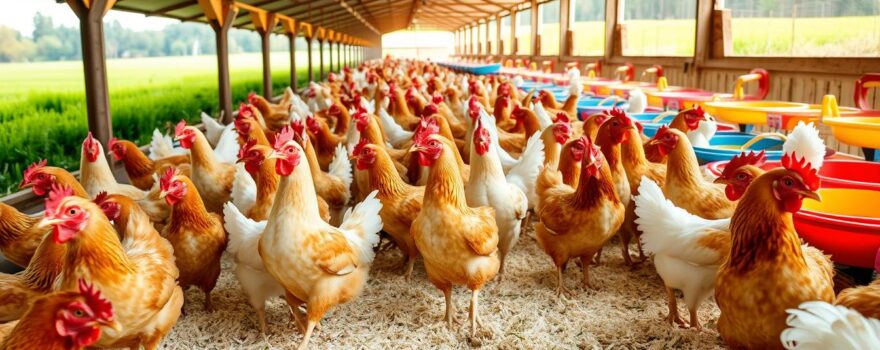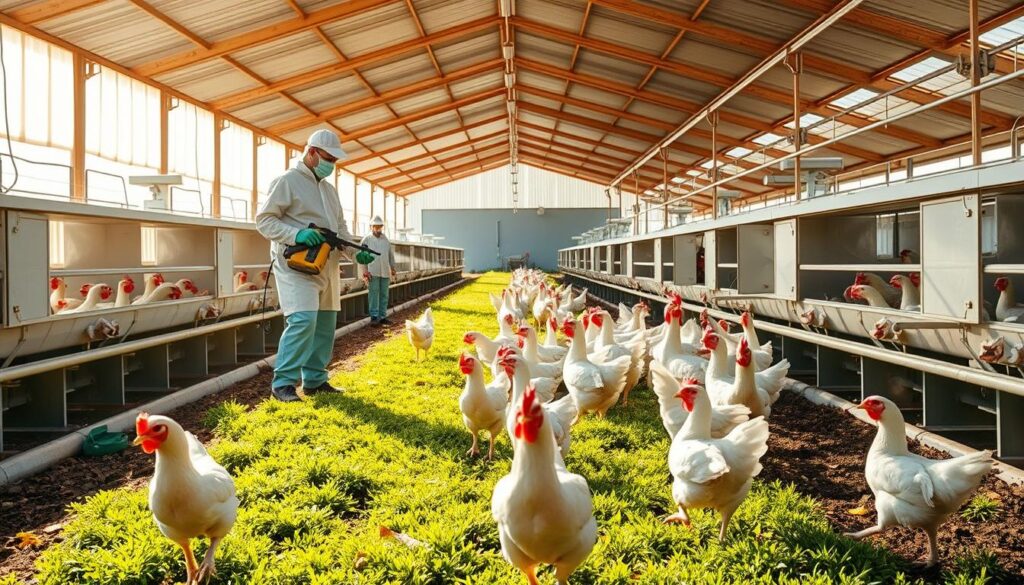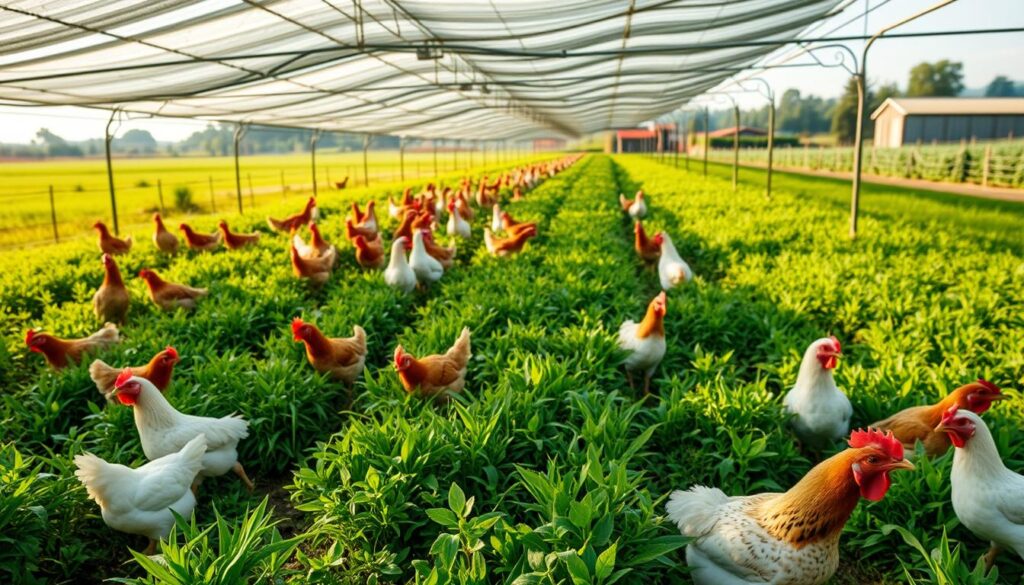
Keeping broiler chickens healthy is key for a successful poultry farm. Bacterial infections are a big challenge for farmers. They can harm the chickens and hurt the farm’s profits. This article will show you how to stop and manage these infections. This will help your farm stay healthy and strong for a long time.
Key Takeaways
- Understand common bacterial pathogens affecting broiler flocks and their symptoms
- Implement strict biosecurity measures to prevent the introduction and spread of bacterial infections
- Develop effective vaccination programs and practice responsible antibiotic use
- Maintain optimal environmental conditions, including temperature, humidity, and ventilation
- Enhance broiler nutrition to support the immune system and disease resistance
- Establish comprehensive sanitation and disinfection protocols
- Monitor flock health regularly and employ early detection strategies
Understanding Bacterial Infections in Broiler Chickens
Keeping broiler chickens healthy is key for any poultry farm’s success. Bacterial infections are a big challenge for producers. Knowing the common bacteria, their symptoms, and effects is crucial for managing these issues.
Common Bacterial Pathogens Affecting Broiler Flocks
Broiler chickens often face infections from Salmonella, Campylobacter, avian pathogenic Escherichia coli (APEC), and Clostridium perfringens. These bacteria can come from contaminated feed, water, or equipment. Wild birds and rodents can also spread them.
Symptoms and Impact on Poultry Health
The signs of bacterial infections in broiler chickens vary. They might show diarrhea, lethargy, or eat less. These infections can harm the flock’s health, leading to slow growth and poor feed efficiency.
| Bacterial Pathogen | Common Symptoms | Impact on Broiler Health |
|---|---|---|
| Salmonella | Diarrhea, lethargy, reduced feed intake | Increased mortality, reduced growth, and feed efficiency |
| Campylobacter | Diarrhea, decreased weight gain | Reduced growth performance and feed conversion |
| Avian pathogenic E. coli (APEC) | Respiratory distress, septicemia, airsacculitis | Increased mortality, condemnation at processing |
| Clostridium perfringens (necrotic enteritis) | Sudden death, reduced feed intake, diarrhea | Severe intestinal damage, poor growth, and feed efficiency |
Knowing the common bacteria and their effects helps producers fight these infections. This knowledge leads to better health and productivity in their flocks.
Implementing Strict Biosecurity Measures
Keeping a strong poultry farm biosecurity program is key to stop bacterial infections in broiler chickens. It’s important to have good biosecurity protocols for poultry farms to prevent bacterial infections in broiler chickens.
Poultry producers need to take these steps:
- Controlled access to the farm, with restricted entry points and visitor sign-in procedures
- Thorough vehicle and personnel disinfection protocols, including foot baths and wheel washes
- Proper disposal of deceased birds, utilizing dedicated disposal areas or composting facilities
- Maintaining clean and well-managed facilities, with regular cleaning and disinfection of equipment and surfaces
| Biosecurity Measure | Importance |
|---|---|
| Controlled Access | Limiting the entry of pathogens and reducing the risk of disease introduction |
| Vehicle and Personnel Disinfection | Preventing the spread of bacteria through contaminated equipment and clothing |
| Proper Disposal of Dead Birds | Eliminating a potential source of infection and disease transmission |
| Facility Cleanliness and Disinfection | Maintaining a clean and hygienic environment to minimize bacterial growth and spread |
By following these biosecurity protocols for poultry farms, producers can lower the risk of bacterial infections in broiler chickens. This helps keep the chickens healthy and productive.
How to Prevent and Manage Bacterial Infections in Broiler Chickens
Keeping broiler chickens healthy and productive is key. It’s not just about keeping them safe from germs. Vaccines and antibiotics are also important in fighting off infections.
Vaccination Programs for Disease Prevention
Vaccines are vital for protecting broiler chickens from diseases. They help fight off Escherichia coli, Salmonella, and Clostridium perfringens. This way, fewer chickens get sick, and antibiotics are used less often.
By using vaccines smartly, farmers can keep their chickens healthier. This makes the whole flock stronger against diseases.
Antibiotic Stewardship and Responsible Use
Antibiotics are crucial in treating infections. But, using them too much can make germs resistant. It’s important to use antibiotics wisely in broiler farms.
Monitoring health closely and treating only when needed helps. This way, antibiotics stay effective. It also lowers the chance of antibiotic resistance in poultry.
Using vaccines and antibiotics carefully helps farmers. It keeps chickens healthy and makes farming more sustainable. This is good for both the chickens and the farmers.
“Preventive measures, such as vaccination and biosecurity, are the cornerstones of sustainable poultry production. By addressing bacterial infections proactively, we can safeguard the health and welfare of broiler flocks while reducing the reliance on antibiotics.”
Maintaining Optimal Environmental Conditions
Creating the best environment for broiler chickens is key to their health. By controlling temperature, humidity, and ventilation, producers can help the birds stay healthy. This makes them less likely to get sick from bacteria.
Temperature and Humidity Control
Broiler chickens do best in temperatures between 70°F and 80°F. If it’s too hot or cold, they get stressed and sick easier. Keeping humidity levels between 50% and 70% is also important. Too much moisture or dryness can cause breathing problems and help bacteria grow.
The Importance of Ventilation
Good ventilation is vital for broiler chickens’ health. It helps control temperature and humidity and removes harmful gases. A well-designed ventilation system keeps the air fresh. This improves the birds’ breathing and immune system, lowering the risk of bacterial infections.
By focusing on environmental factors for broiler chicken health, producers can protect their flocks. This includes temperature and humidity control in poultry farms and the importance of ventilation in broiler production. These steps help reduce the impact of bacterial diseases.
Enhancing Broiler Chicken Nutrition
Good nutrition is key for broiler chickens’ health and fighting off bacteria. Poultry farmers can use special diets to boost their immune system. This helps chickens fight off harmful bacteria better.
Dietary Strategies for Immune System Support
Adding probiotics and prebiotics to their food is a smart move. Probiotics are good bacteria that keep the gut healthy. Prebiotics feed these bacteria, making the immune system stronger.
Other nutrients like vitamins E, zinc, and selenium are also important. They help the chicken’s immune system work better. This is part of a strong diet for immune support.
- Incorporate probiotics and prebiotics in the broiler feed to support gut health and immune function.
- Ensure adequate levels of key vitamins, minerals, and antioxidants in the broiler diet to bolster the immune system.
- Regularly monitor and adjust the broiler chicken nutrition to optimize overall health and disease resistance.
“Proper nutrition is the foundation for a strong, resilient immune system in broiler chickens, helping them ward off bacterial infections and maintain optimal health.”
By using these dietary strategies for immune system support, farmers can improve the broiler chicken nutrition. This makes the chickens better at fighting off infections. It helps the whole poultry operation succeed.
Effective Sanitation and Disinfection Protocols
Keeping a clean environment is key for broiler chicken farms to stop bacterial infections. It’s important to have strong poultry farm sanitation and disinfection protocols for broiler chicken houses. This helps keep the chickens healthy and happy.
To stop bacterial infections in broiler chickens, a detailed plan is needed. Start by cleaning all surfaces well. This includes walls, floors, and equipment. This removes harmful pathogens that could harm the chickens.
- Use approved disinfectants that kill many types of bacteria, viruses, and fungi.
- Make sure the disinfectant is on the surfaces long enough to work well.
- Focus on areas where bacteria tend to gather, like high-traffic spots and hidden places.
- Don’t forget to clean and disinfect water lines, feeders, and other equipment to stop biofilm buildup.
Having a strong biosecurity program and strict sanitation rules are vital. They help make a clean and safe place for broiler chickens. By following these steps, farmers can lower the chance of bacterial infections. This helps keep the chickens healthy and happy.
“Consistent and thorough disinfection is the foundation of a successful disease prevention program in broiler chicken production.”

Monitoring and Early Detection Strategies
Spotting bacterial infections early is key to stopping disease spread in broiler flocks. Regular health checks and tests are crucial. They help farmers quickly find and fix bacterial infections.
Regular Flock Health Checks and Diagnostics
Keeping a close eye on broiler chicken health is vital for catching bacterial infections early. Farmers should watch for any changes in how birds act, eat, or look. These signs can point to a poultry disease.
- Look for signs like birds being tired, eating less, having trouble breathing, or acting strangely.
- Watch for physical signs like diarrhea, trouble walking, or skin problems that could mean a bacterial infection.
- Check the flock’s weight regularly to see how they’re growing and spot any problems.
Diagnostic testing also helps understand the flock’s health. It involves lab tests on bird samples like blood, poop, or tissue. These tests can find specific bacterial pathogens.
By doing regular health checks and targeted tests, farmers can stay ahead of bacterial infections. This lets them act fast to protect their flock’s health and keep their operation running well.
Sustainable Poultry Farming Practices
The poultry industry is changing, focusing more on sustainable farming. This shift aims to lessen environmental harm and ensure sustainable broiler production for the future. By using the strategies mentioned, producers can help make poultry farming better for the planet. This includes reducing the need for antibiotic-free poultry farming and improving how they manage their flocks’ health.
Using antibiotics wisely is key in sustainable poultry farming. Too much use can make bacteria resistant to antibiotics, harming animals and humans. By following strict rules on antibiotics, producers can keep their flocks healthy. They do this through better biosecurity, the right environment, and nutrition.
Sustainable farming also helps lessen the environmental impact of poultry farming. This includes cutting down on waste, saving natural resources, and lowering carbon emissions. By using green energy, managing waste well, and adopting precise farming, producers can make the poultry industry greener.
By adopting these sustainable methods, producers can improve their flocks’ health and their business’s future. As people care more about the environmental impact of poultry farming, sustainable broiler production will stand out. This will help producers meet the changing needs of the market.
| Sustainable Poultry Farming Practices | Benefits |
|---|---|
| Responsible antibiotic use | Reduced antibiotic resistance, improved flock health |
| Optimization of environmental conditions | Improved animal welfare, reduced energy consumption |
| Waste management and resource conservation | Reduced environmental impact, cost savings |
| Precision farming techniques | Enhanced productivity, data-driven decision making |

“Sustainable poultry farming is not just a trend, but a necessity for the long-term viability and growth of the industry. By embracing these practices, producers can make a meaningful contribution to the environment while also enhancing the health and welfare of their flocks.”
Addressing Antibiotic Resistance in Poultry Production
The rise of antibiotic-resistant bacteria is a big problem for the poultry industry. It’s important to use antibiotics wisely. But, there are other ways to fight this issue and keep poultry farming sustainable.
Alternative Interventions and Emerging Solutions
Phage therapy is a new method that uses viruses to kill specific bacteria. This way, it helps manage infections without making bacteria resistant to antibiotics. Competitive exclusion also helps by introducing good bacteria that outcompete the bad ones.
Natural antimicrobial compounds, like essential oils from plants and organic acids, are another option. They can harm bacterial cell membranes and boost the bird’s immune system. This helps reduce antibiotic use and fight resistance.
Research and new ideas in poultry farming are leading to better solutions. By using these alternatives, the industry can protect bird health and keep farms productive. This helps in the fight against antibiotic-resistant bacteria.